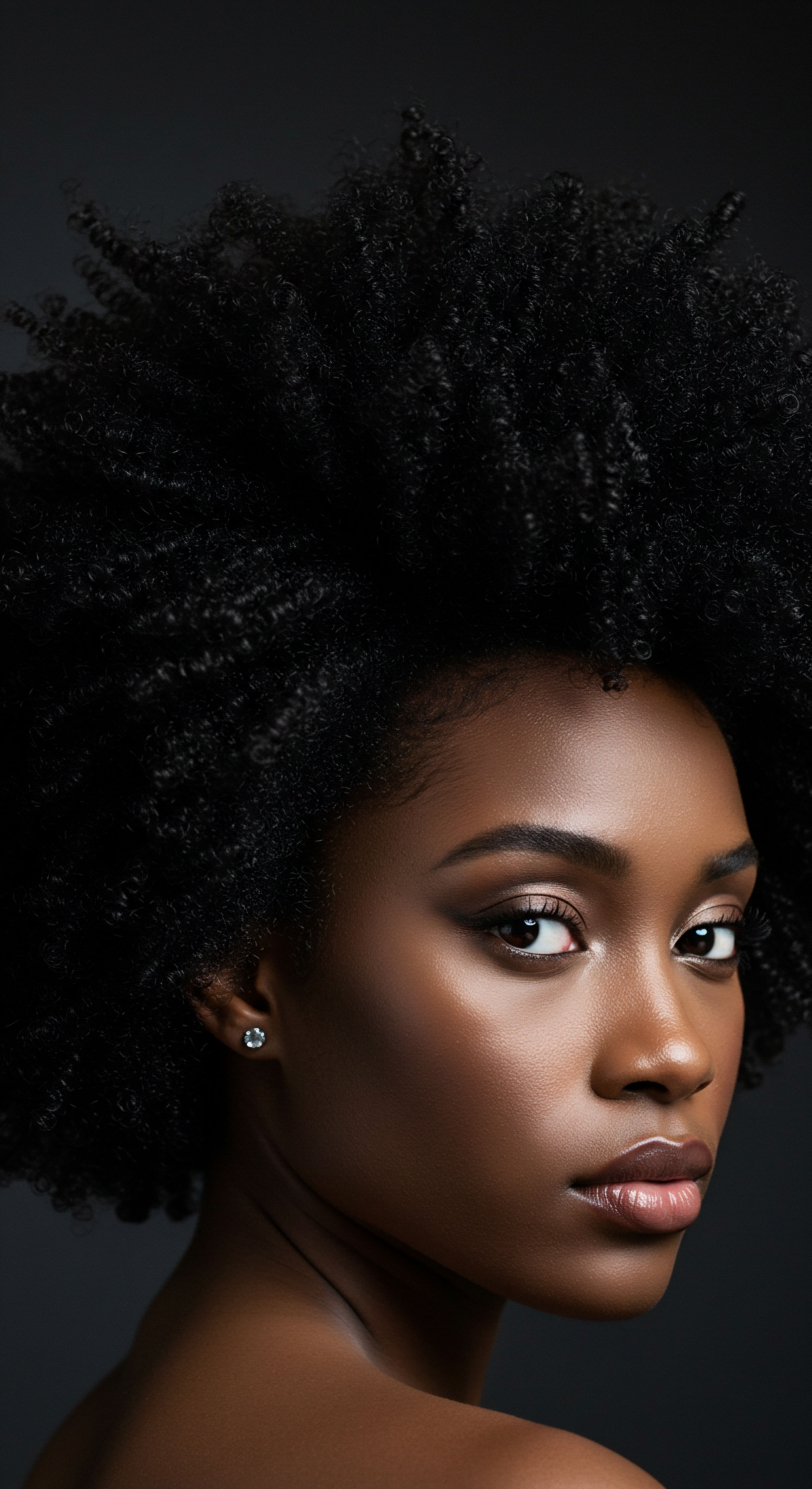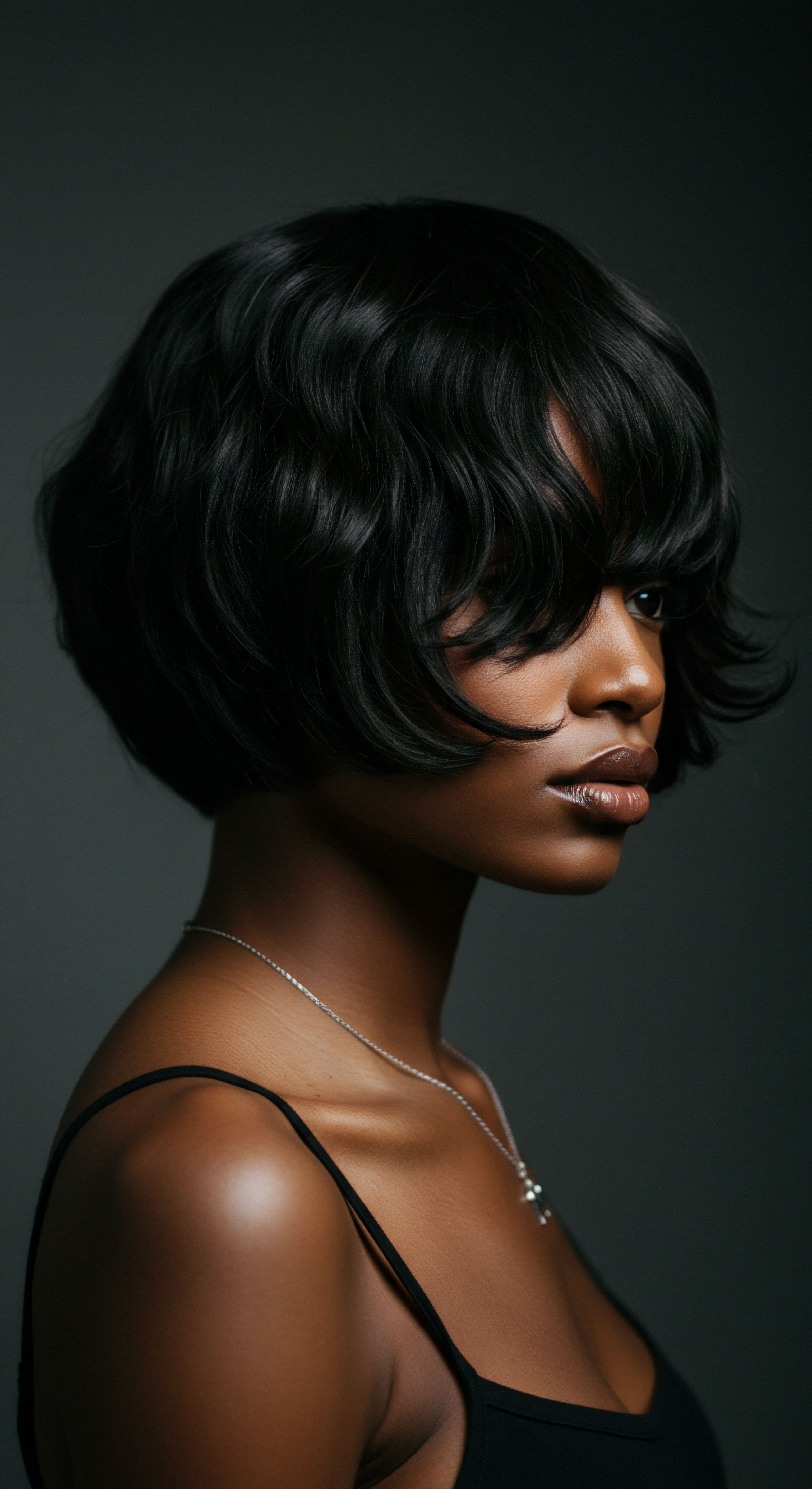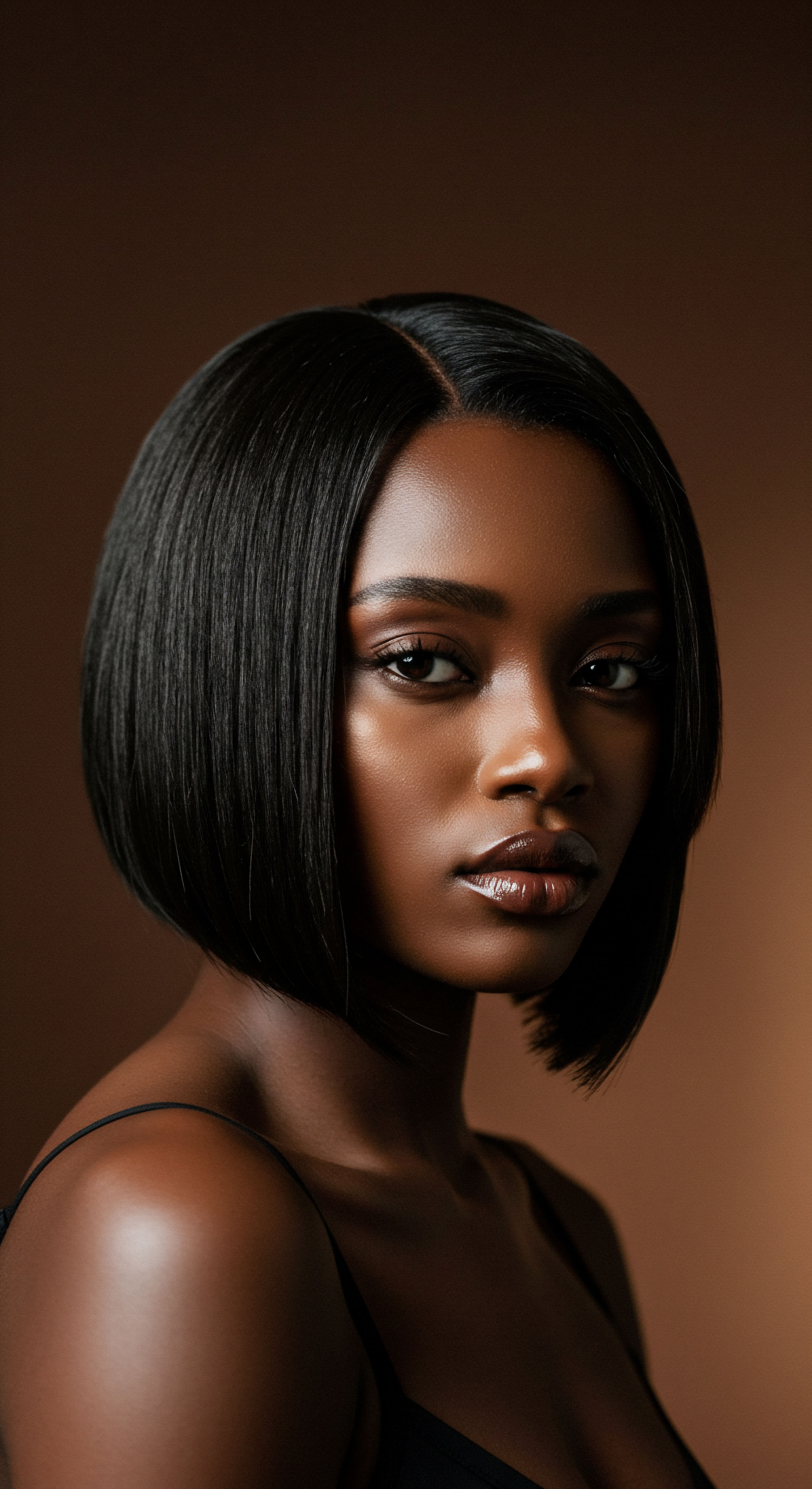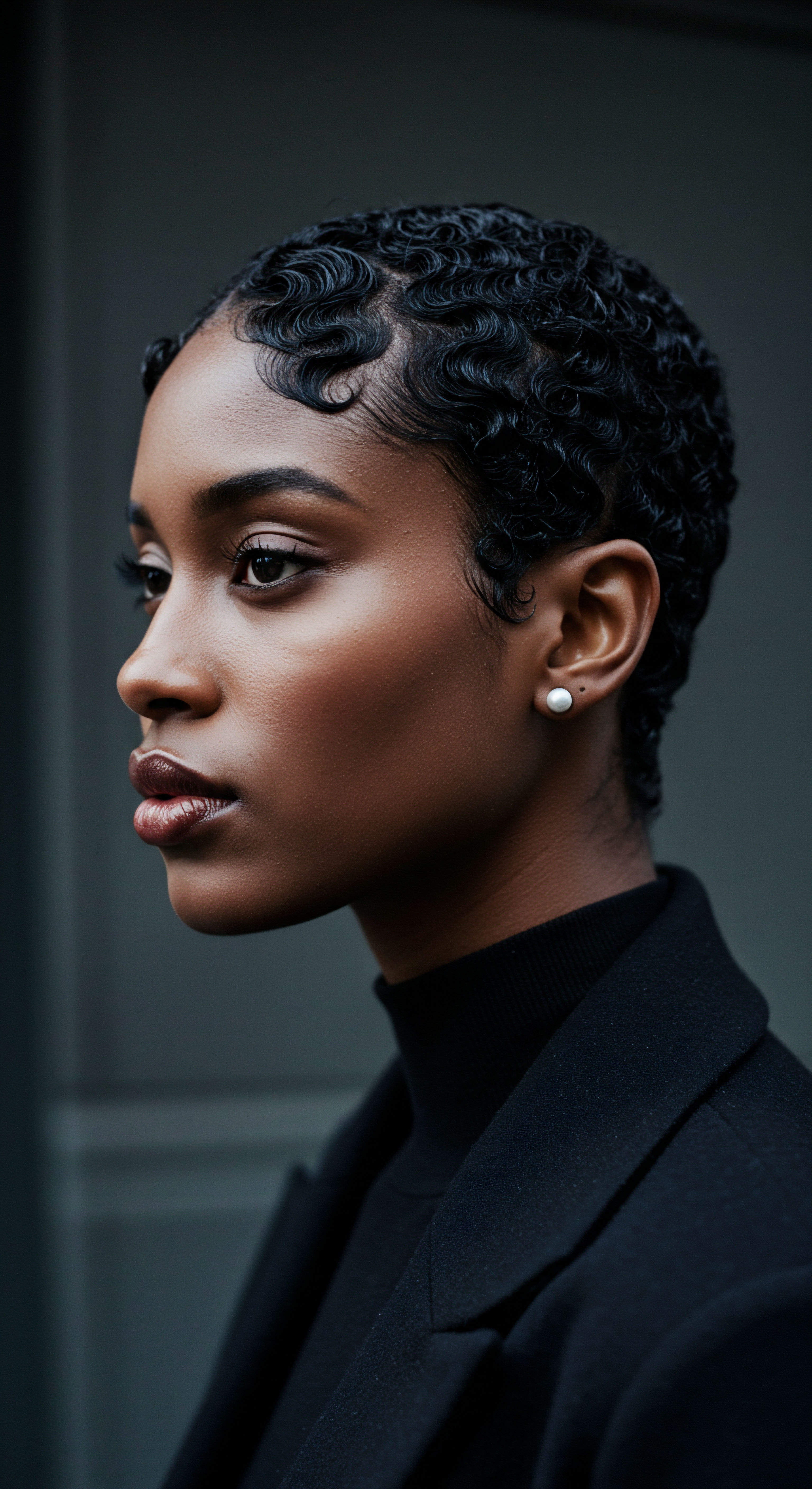
Roots
Long before the shelves of modern beauty emporiums overflowed with specialized concoctions, the arid winds of ancient Egypt whispered secrets of botanical wisdom, revealing how early inhabitants cared for their crowning glory. A deep respect for personal presentation permeated every layer of Egyptian society, transcending mere vanity. Hair, in particular, held a significant place, not simply as an adornment but as a symbol of vitality, status, and even a connection to the divine. This understanding was not born from fleeting trends, but from a profound attunement to the natural world and the necessities of a challenging climate.
The sun, a constant and powerful presence, could be harsh, its relentless rays drying and damaging. Against this backdrop, the plants of the Nile Valley and beyond became trusted allies, their properties discovered and refined over centuries of careful observation.
Consider the desert itself, a landscape of stark beauty and demanding conditions. Survival depended on resourceful living, and this ethos extended to personal care. The Egyptians, both men and women, recognized the imperative of maintaining their hair’s integrity against such environmental pressures.
Their solutions were not fleeting fads but time-tested applications of natural elements, passed down through generations. These early practices underscore a fundamental truth ❉ human ingenuity, when faced with a need, often turns to the earth for answers.
Ancient Egyptians cultivated a profound connection with nature, transforming readily available botanicals into essential remedies for hair health.

Why Hair Held Such Value
For the ancient Egyptians, hair was more than just a collection of strands; it was a canvas, a statement, a reflection of one’s inner and outer world. Elaborate hairstyles and wigs were common, worn by royalty and commoners alike, each style often signifying age, gender, or social standing. The youthful side-lock, for example, marked children until puberty, a distinctive S-shaped curl depicted in hieroglyphs.
Men often favored shorter styles, while women in the New Kingdom embraced longer coiffures, often augmented with extensions and wigs, decorated with beads, flowers, and ribbons. Such attention to detail underscored the importance of maintaining hair’s condition, as a lackluster appearance would detract from the overall aesthetic and symbolic message.
Beyond aesthetics, hair care possessed a practical dimension. The desert climate presented challenges like dryness and the unwelcome presence of lice. Natural oils and pastes served a dual purpose ❉ they moisturized and softened, while also helping to deter pests. This holistic approach, addressing both beauty and hygiene, highlights the pragmatic yet deeply symbolic nature of Egyptian self-care rituals.

The Foundations of Ancient Botanical Hair Care
The plant kingdom offered a rich palette of resources. Early Egyptians observed, experimented, and documented the effects of various botanicals, creating a pharmacopeia of hair treatments. These foundational ingredients, often extracted as oils or ground into powders, formed the bedrock of their moisturizing practices. Their knowledge, documented in texts like the Ebers Medical Papyrus, reveals a sophisticated understanding of plant properties that echoes into modern times.
- Castor Oil ❉ A cornerstone of Egyptian hair care, this thick oil was highly valued for its conditioning properties, promoting shine and strengthening hair. It was even associated with legendary figures like Cleopatra for maintaining lustrous locks.
- Almond Oil ❉ Renowned for its ability to soften and nourish, almond oil was a common ingredient in hair treatments and ointments, contributing to silky smooth strands.
- Moringa Oil ❉ Often called “Ben Oil” or the “miracle oil,” moringa was prized for its light texture and rich antioxidant content. It provided deep nourishment to the scalp and hair, protecting against the harsh desert environment. Jars of moringa oil have been discovered in ancient Egyptian tombs, underscoring its value.

Ritual
Moving beyond the elemental recognition of plant properties, the ancient Egyptians transformed hair care into a ritual, a daily or periodic practice imbued with purpose and gentle intention. It was a conscious act of tending, a conversation between the individual and the botanical world. This section explores the practical wisdom of these applications, the methods they employed, and how these ancient routines offered tangible benefits for hair’s moisture and overall well-being.
The concept of ritual in Egyptian society extended to nearly every facet of life, and personal grooming was no exception. These were not hurried affairs but deliberate acts, often accompanied by a sense of calm and self-respect. The careful preparation of oils, the methodical application, and the sensory experience of natural aromas all contributed to a practice that nourished not only the hair but also the spirit.
Ancient Egyptian hair care was a thoughtful ritual, transforming botanical ingredients into practical applications for moisture and health.

How Did Ancient Egyptians Apply Plant-Based Moisturizers?
The application methods were as considered as the ingredients themselves. Oils, often warmed gently, were massaged into the scalp and along the hair shaft. Combs, sometimes crafted from fish bones, aided in distributing the oils evenly. This methodical approach ensured that the moisturizing properties of the plants reached where they were most needed, penetrating the hair and scalp to combat dryness.
For deeper conditioning, some treatments involved leaving the oils on for extended periods, perhaps even overnight, allowing for thorough absorption. The use of certain plants as hair masks, sometimes combined with other natural ingredients like honey, provided intense nourishment and shine. This layered approach to hair care, combining direct application with more intensive treatments, speaks to a nuanced understanding of hair’s needs.

The Daily and Periodic Practices
Daily care might involve lighter applications of oils to maintain softness and shine, particularly important in the dry desert air. For more significant treatments, a weekly or bi-weekly routine might be adopted, involving more substantial oiling or the use of specific plant pastes. These routines were often communal, a shared aspect of domestic life, reinforcing the cultural significance of hair care.
- Oil Application ❉ Ancient Egyptians regularly applied oils like Castor Oil and Almond Oil to their hair to keep it silky smooth and moisturized. These oils served to combat the drying effects of the climate and could even help deter lice.
- Hair Masks and Pastes ❉ Ingredients such as Fenugreek Powder, rich in proteins and mucilages, were mixed with water or other liquids to form nourishing hair masks. These helped to strengthen hair fibers, prevent loss, and provide deep hydration.
- Warm Oil Treatments ❉ For deeper penetration and enhanced benefits, oils were often warmed before application, massaged into the scalp, and sometimes covered with a warm towel. This practice mirrors modern hot oil treatments, highlighting the timeless nature of effective hair care techniques.
| Plant/Oil Castor Oil |
| Primary Moisturizing Property Rich fatty acids for deep conditioning |
| Additional Benefits Strengthening, promoting growth, adding shine, deterring lice |
| Plant/Oil Almond Oil |
| Primary Moisturizing Property Emollient properties for softening |
| Additional Benefits Nourishment, detangling, general cosmetic enhancement |
| Plant/Oil Moringa Oil |
| Primary Moisturizing Property Lightweight hydration, rich in antioxidants |
| Additional Benefits Scalp nourishment, growth promotion, sun protection |
| Plant/Oil Olive Oil |
| Primary Moisturizing Property Squalane and Vitamin E for moisture |
| Additional Benefits Frizz reduction, split end support, cleansing, protection |
| Plant/Oil Fenugreek |
| Primary Moisturizing Property Mucilages for detangling and hydration |
| Additional Benefits Protein for strengthening, sebum regulation, anti-inflammatory |
| Plant/Oil These ancient botanicals provided multifaceted benefits for hair health. |

Relay
The journey through ancient Egyptian hair care extends beyond simple application; it delves into the deeper interplay of science, culture, and enduring human practices. This section relays a more sophisticated understanding of the botanicals employed, their specific chemical contributions to hair health, and the profound cultural significance that elevated these practices beyond mere personal grooming. It is here that we uncover the intricate layers of knowledge that underpinned their radiant hair.
To truly grasp the wisdom of the ancients, we must look at their environment, their beliefs, and the resources at hand. The desert, while challenging, also offered unique flora adapted to its conditions. The Egyptians learned to harness the resilience of these plants, understanding their inherent properties long before modern scientific methods could dissect them. This profound observational science, combined with cultural reverence for beauty and health, shaped a comprehensive approach to hair care.
Ancient Egyptian hair care was a sophisticated interplay of botanical science, cultural values, and a deep understanding of natural properties.

What Specific Chemical Components in Ancient Plants Hydrated Hair?
The effectiveness of these ancient plant-based moisturizers lies in their natural chemical compositions. For example, Castor Oil, a primary agent, is rich in ricinoleic acid, a monounsaturated fatty acid that provides substantial conditioning and helps to seal moisture into the hair shaft. This fatty acid contributes to the oil’s thick consistency, allowing it to coat strands and minimize water loss.
Similarly, Moringa Oil, known as “Ben Oil” due to its high concentration of behenic acid (a saturated fatty acid), offers lightweight yet deep hydration. Its rich antioxidant profile, including vitamins A, C, and E, helped protect hair from environmental stressors like the relentless desert sun. Olive Oil, another staple, contains squalane and vitamin E, powerful moisturizers and antioxidants that reduce frizz and help to repair damaged hair. These components demonstrate a remarkable alignment between traditional usage and contemporary scientific understanding of lipid and antioxidant benefits for hair.

How Did Ancient Egyptians Create Advanced Hair Treatments?
The Egyptians’ ingenuity extended to creating more advanced treatments, sometimes incorporating unexpected elements. A notable discovery, for instance, comes from the analysis of hair samples from ancient mummies. Researchers found that a fat-based ‘gel’ containing biological long-chain fatty acids, specifically Palmitic Acid and Stearic Acid, was used to style and set hair in place.
This ‘gel’ was present on both natural and artificially mummified bodies, suggesting it was a beauty product used during life as well as a part of funerary rituals. This finding, from a study by Natalie McCreesh and colleagues at the University of Manchester, UK, on hair samples from 18 mummies, indicates a sophisticated understanding of how to maintain hair’s structure and appearance even in the afterlife.
Another compelling example of their advanced understanding is seen in the preparation of Black Castor Oil. Unlike regular castor oil, the ancient Egyptians discovered that roasting castor beans before pressing them produced ashes that, when infused into the oil, released sulfur. This sulfur content is particularly relevant because hair’s primary protein, Keratin, is high in sulfur. A lack of sulfur can lead to brittle hair.
Therefore, this ancient method effectively created a product that could strengthen hair and promote growth by providing a key building block for the hair structure. This nuanced approach, modifying preparation methods to enhance specific benefits, showcases a deep, practical scientific knowledge.

Beyond Aesthetics ❉ The Deeper Cultural Meanings
The use of these plant-based moisturizers was intertwined with broader cultural and spiritual beliefs. Hair care was not merely about looking good; it was a reflection of purity, health, and a connection to the cosmic order. The meticulousness of their beauty rituals mirrored the precision seen in their architecture, art, and religious practices.
The very act of anointing hair with fragrant oils, such as those infused with frankincense or myrrh (though primarily used for perfume and ritual, their oil bases would have conferred moisturizing benefits), was seen as a way to purify and connect with deities. These scents, believed to carry prayers to the gods, transformed a personal act into a sacred offering. Pomegranate oil, while also a moisturizer, carried symbolism of renewal and vitality, often depicted in tombs and temples. Thus, the plants chosen for hair care provided both tangible benefits and served as conduits for spiritual expression and cultural identity.
| Plant/Oil Castor Oil |
| Key Chemical Components Ricinoleic acid |
| Mechanism of Benefit for Hair Coats hair, seals moisture, supports cuticle smoothing |
| Plant/Oil Moringa Oil |
| Key Chemical Components Behenic acid, Vitamins A, C, E |
| Mechanism of Benefit for Hair Lightweight conditioning, antioxidant protection, scalp health |
| Plant/Oil Olive Oil |
| Key Chemical Components Squalane, Vitamin E, Phenols |
| Mechanism of Benefit for Hair Hydration, antioxidant defense, frizz reduction, cuticle repair |
| Plant/Oil Fenugreek |
| Key Chemical Components Proteins, Mucilages, Saponins, Flavonoids |
| Mechanism of Benefit for Hair Strengthens hair structure, detangles, regulates sebum, antioxidant protection |
| Plant/Oil Black Castor Oil |
| Key Chemical Components Sulfur (from roasted beans) |
| Mechanism of Benefit for Hair Supports keratin production, strengthens hair, promotes growth |
| Plant/Oil The chemical makeup of these ancient botanicals directly contributed to their efficacy in hair care. |

Reflection
As we gaze back through the sands of time to ancient Egypt, a clear message emerges from their meticulously preserved beauty practices ❉ the quest for healthy, radiant hair is a timeless human pursuit. Their reliance on nature’s bounty, their deep understanding of botanical properties, and their integration of hair care into a broader cultural and spiritual framework offer a profound lesson. The subtle art of tending to textured hair, then as now, called for patience, observation, and a respectful partnership with the earth.
The gentle touch of almond oil, the fortifying strength of castor, the protective shield of moringa – these were not just ingredients but extensions of a philosophy that saw beauty as an intrinsic part of well-being. Their rituals, far from being simplistic, contained layers of practical wisdom and scientific insight, even if uncodified in modern terms. We see echoes of their practices in today’s natural hair movement, a testament to the enduring power of ancient knowledge. What quiet wonders might still be uncovered, waiting to share their timeless secrets for our strands?

References
- Blackman, Aylward M. Middle Egyptian Stories. Bibliotheca Aegyptiaca. Bruxelles ❉ Fondation Égyptologique Reine Élisabeth, 1953.
- Breasted, James Henry. Ancient Records of Egypt ❉ Historical Documents from the Earliest Times to the Persian Conquest. Vol. 1 ❉ The First to the Seventeenth Dynasties. Chicago ❉ University of Chicago Press, 1906.
- McCreesh, Natalie, Andrew S. G. D. Gowland, and Stephen Buckley. “Ancient Egyptian hair gel ❉ New insight into ancient Egyptian mummification procedures through chemical analysis.” Journal of Archaeological Science 38, no. 11 (2011) ❉ 3204-3209.
- Panyapanya, T. “A Timeless Beauty ❉ The History and Uses of Moringa Oil.” Panya Natural, 2018.
- Pyramide Cosmetics. “Beauty Rituals of Ancient Egypt.” Pyramide Cosmetics, 2022.
- Shea Terra. “100% Pure Egyptian Black Castor Oil.” Shea Terra Organics.
- TheCollector. “Ancient Egypt’s Most Indulgent Beauty Secrets.” TheCollector, 2022.
- UCL Discovery. “The Social and Ritual Contextualisation of Ancient Egyptian Hair and Hairstyles from the Protodynastic to the End of the Old Kingdom.” UCL Discovery.
- Vertex AI Search. “From Ancient Egypt to Modern Beauty ❉ Timeless Cosmetic Secrets.” Egyptra Travel Services, 2025.
- Vertex AI Search. “Hair Care Secrets of the Past ❉ What Our Ancestors Used for Healthy Hair.” 2024.